#'meatloaf'
Text
#of two minds#wordgirl#theodore tobey mccallister iii#tobey mccallister#wordgirl tobey#charlie#'meatloaf'#or manny?#dr two brains#dr two brains henchmen#context not identifamied
26 notes
·
View notes
Text


31K notes
·
View notes
Text

ASL X SPLATOON!
🐙🔥 🦑🎩 🐙👒
(My little guys!!!)
#one piece#one piece art#op ace#portgas d ace#one piece portgas d ace#one piece ace#meatloaf draws#one piece luffy#monkey d. luffy#luffy#straw hat luffy#op luffy#luffy fanart#sabo fanart#sabo#flame emperor sabo#chief of staff sabo#op sabo#one piece sabo#revolutionary sabo#fire fist ace#ace#one piece asl#asl brothers#asl trio#ASL#splatoon 3#splatoon art#splatoon#splatpost
2K notes
·
View notes
Text



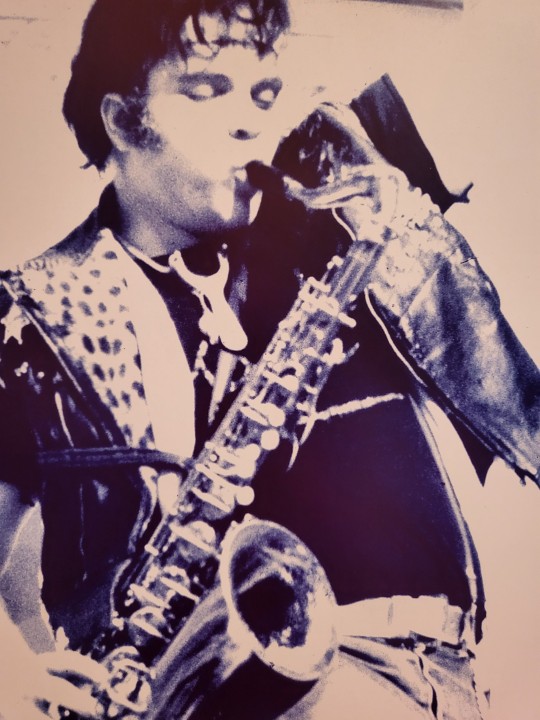


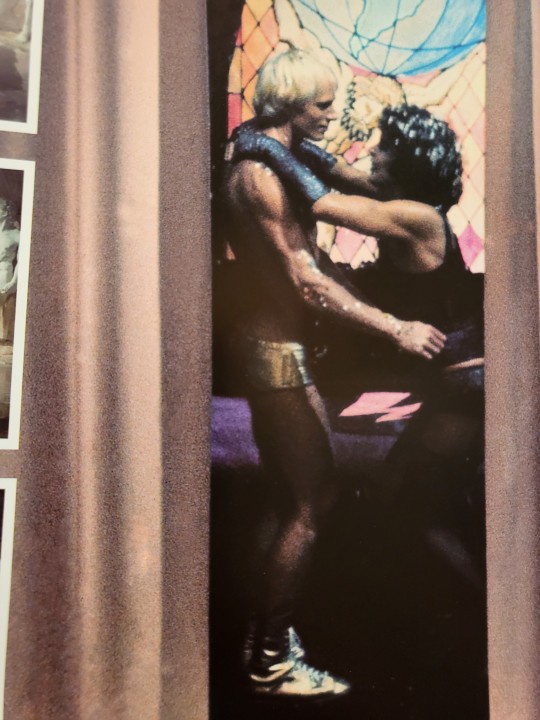

#more scans#with all the rocky horror talk I looked through my book and wanted to share these x3#rocky horror picture show#frank n furter#meatloaf#rocky horror#don't dream it be it#tim curry#the photos of him so#🥹#photobook scans#mick rock
3K notes
·
View notes
Text

Did he get his meatloaf tho?
#art#artists on tumblr#fanart#spencer agnew#smosh#smosh games#smosh fanart#fred darts#meatloaf#my art
655 notes
·
View notes
Text



Loaded potato and meatloaf casserole
#meatloaf#beef#bacon#food#dinner#meal#cheese#potatoes#mashed potatoes#loaded potato#casserole#cheesy#main dishes#tasty#foodporn#delicious#cooking#food photography#foodgasm#recipe
515 notes
·
View notes
Text
show me devotion // and take me all the way
yt link✨
#rome wasnt built in a day but this sure was#roll up come get your carly rae omens#good omens#good omens fanvid#idgaf about beatmatching or swish transitions at this point a) it wont beat meatloaf and b) this just needed to get the fuck Done
595 notes
·
View notes
Text

#i simply think he wouldn’t have bothered to change his username after the incident. purely because the pun is so good /j#wordgirl#dr two brains#how do i tag his henchmen….#meatloaf and charlie#???? IDK#no id#giddly’s art
191 notes
·
View notes
Text




615 notes
·
View notes
Text
alt text is not the place for fucking commentary, ESPECIALLY if you don't describe the image at all and ONLY include your commentary.
alt text is not a cheeky aside. it's not a private whisper to your friend.
alt text is an accessibility tool. fucking use it that way.
#bluh bluh#saw someone make a cool parody of a meatloaf album cover and was v excited to see it was alt texted#clicked on the alt text and it was just a little comment about the artist who did the original cover and how op had never seen it before#needless to say. flames on the sides of my face
668 notes
·
View notes
Text

(ᴗ˳ᴗ)
#one piece#one piece art#one piece law#trafalgar law#trafalgar d water law#op law#heart pirates#he drinks his tea and pouts#Cora gave him that cup and he has had it for YEARS#and no one else is allowed to use it#meatloaf draws
5K notes
·
View notes
Text
meatloaf fancam!
meatloaf fancam!
202 notes
·
View notes
Text
Wet Beast Wednesday: chitons
For last week's Wet Beast Wednesday I talked about a weird invertebrate whose name starts with "c" so this week I'm gonna branch out from that and talk about a weird invertebrate whose name starts with a "c". Chitons are marine mollusks of the class Polyplacophora that bear a resemblance to limpets, but have a segmented shell that allows for more flexibility. They are named after a form of clothing worm by the ancient Greeks.
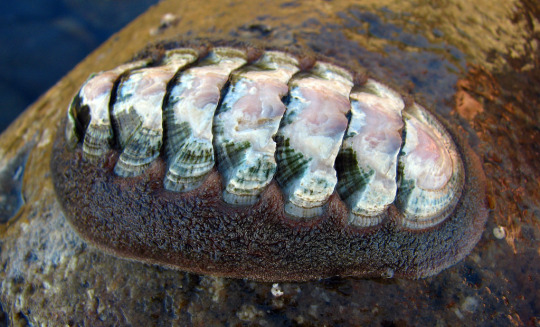
(image id: a chiton. It is an oval animal with a flat shell composed if 8 overlapping green and white plates. Surrounding the shell is brown, soft tissue)
Chitons are similar in appearance and ecology to limpets, though they are not closely related. The shell of a chiton is made of 8 plates called valves. Valves are the name of any mollusk shell that is divided into multiple pieces. Most mollusk shells are made of one continuous piece and the only ones that have valves are the chitons, bivalves, and a few weird snails. The valves of a chiton overlap slightly, allowing for flexibility while still giving protection. Chitons can curl up into balls and flex backwards to move over concave surfaces that limpets wouldn't be able to. The valves are imbedded in and held together by a thick, muscular ring called the girdle that encircles the body. In most species, only the sides of the valves are covered by the girdle, leaving the rest exposed to the water. A few species cover more or all of the valves with the girdle. When a chiton dies and the girdle decays, the valves will separate. Individual valves sometimes wash up on beaches and are called butterfly shells due to their v-shaped appearance. The shell is used for defense. Chitons can curl up in a ball when not attached to a rock. If one is attached to a rock, it can suction on, presenting predators with no good way to attack its soft underbelly. Some species have spikes, bristles, or other ornaments on their valves and girdles that can provide additional protection.
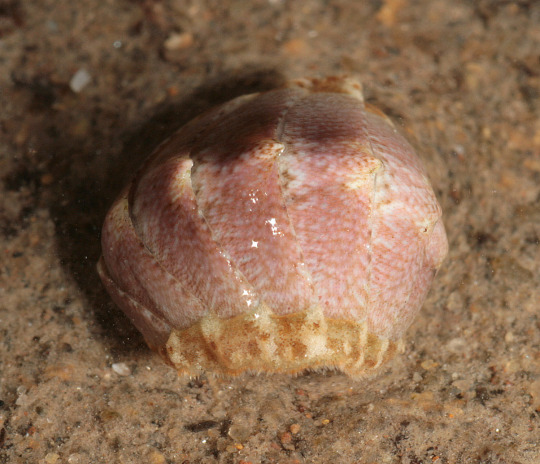
(image: a chiton curled up into a ball. Its plates are pale pink and its girdle is white and brown)
Underneath the shell, the chiton's body is soft. It consists largely of a muscular foot that is used for movement. To either side of the foot is the mantle cavity, which consists of channels filled with gills that water is pulled through. There is no distinct head, but a mouth is present on the front end. Inside the mouth is the radula, a tongue-like appendage that is covered in teeth. The teeth are special because they are coated in magnetite, a very hard magnetic mineral that has iron as one of its main ingredients. While the metal is used to reinforce the teeth and keep them from wearing out (in fact, the chiton Chaetopleura apiculata has the hardest teeth of any known animal), it may also be used for magnetoreception. This is when an animal can sense magnetic fields. It is possible that the magnetic teeth of chitons can sense the Earth's magnetic field and help with navigation and migration. Most chitons are herbivores or omnivores that feed on algae, bryozonans, diatoms, and other tiny rock-dwellers by scraping at rocks with their radulae. Some are carnivores that target barnacles and can even eat small crustaceans and fish. They often hunt by holding the front ends of their girdles up in the water. Should an animal mistake it for shelter, the chiton will clamp down on them. Food is forced through the esophagus by a current of mucus moved by cilia.

(image: the underside of a chiton. it is oval and orange all over. Two groves filled with brown gill filaments go down each side of the body, encircling a central foot. The mouth is visible as a small hole on one end)
When it comes to senses, chitons have a few options. Like their gastropod cousins, chitons have a chemosensory organ called the subradular organ used for smell and their feet and girdles are full of sensory nerves. They also have special organs called aesthetes. These consist of light-sensing cells that are just below the surface of the shell. The aesthetes are not true eyes, only being able to distinguish light from dark, though they can tell the difference between a shadow and the effects of clouds moving over the sun. Some species use collections of aesthetes to form simple eyes called shell eyes. Unlike the aesthetes, the shell eyes can form images, though Chitons do not have nerve structures needed to form a high resolution image. Shell eyes are distinct from those of any other animal in their structure. Most animals have eye lenses made of protein-based structures, but chiton lenses are crystalline, made of aragonite, the same material that makes up the shell of most mollusks. Each shell eye is compound. The shell eyes are almost certainly used for predator detection. Fossil chitons have been found dating back to the Cambrian period. but shell eyes have only been found in fossils from less than 10 million years old. This likely makes chitons the most recent animal group to have evolved true eyes. Chiton eyes have also been found to work both in water and air, which is tricky due to the way light travels differently through both mediums.
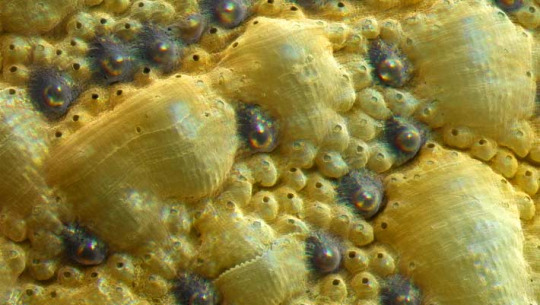
(image: a close-up of a chiton's shell showing the eyes. The shell is yellow and lumpy with the eyes visible as darker, almost black lumps)
The majority of chitons live in intertidal or sub-tidal areas, making them a shallow water group. A few species have been found living in much deeper water, up to 2,000 meters down. Chitons have been known to have homing behavior as they will consistently return to a safe spot after feeding. How they do this is unknown. Sensing the magnetic field of the Planet may play a role, though it is also possible that they lay down chemical trails to find their way home. Chitons are broadcast spawners, with both males and females releasing gametes into the water. Larvae can swim for a while before moving to the substrate.

(image: microscope images of a chiton larva at 4 different developmental stages. It begins as a round blob ringed with hair-like cilia. As the animal develops the cilia recede and the animal elongates, with a distinct foot becoming visible. source)
I will close by bringing up an animal I only learned about recently but has rapidly become one of my favorite weird beasts. This is Cryptochiton stelleri. Its common name is the gumboot chiton, but some people call it the wandering meatloaf, which is objectively the best name ever. It is the largest chiton, growing up to 36 cm (14 in) and 2 kg (4.4 lbs). Its girdle completely covers its shell, which does make it look more like a meatloaf. They can live up to 40 years and are the first known animals to have the mineral santabarbarite in their bodies. They live throughout the north pacific and have been used as a food source by many different cultures. There may be a lot of bad stuff in the world, but if things get too bad, just remember that we live on the same planet as an animal called the wandering meatloaf that can live for 40 years and has a tongue covered in magnetic teeth.

(image: a wandering meatloaf. It is an ovoid animal with red-orange tissue covering the body. Its shell is not visible, but the ridges where each plate overlaps can be seen through the girdle)
#wet beast wednesday#chiton#wandering meatloaf#gumboot chiton#mollusk#molluscs#marine biology#biology#zoology#ecology#animal facts#marine animals
460 notes
·
View notes
Photo
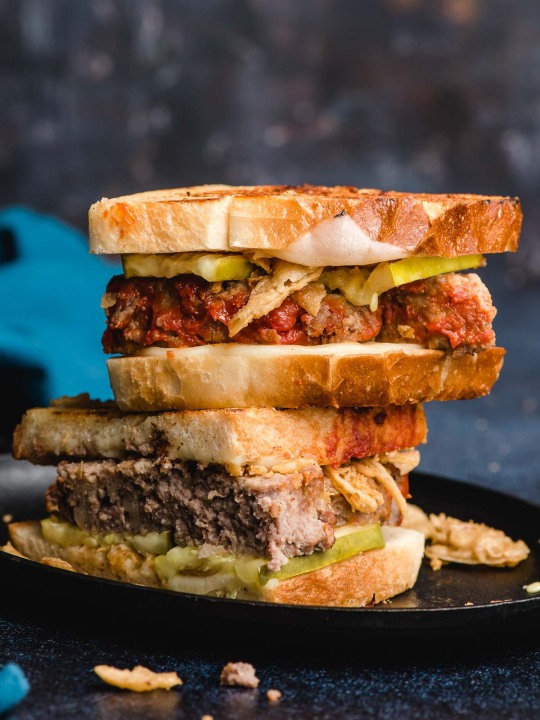
Hot and cheesy meatloaf sandwich
#meatloaf#meatloaf sandwich#sandwich#cheese#food#beef#onion#fried onions#crispy onions#main course#dinner#cheesy#easy recipes#foodporn#delicious#cooking#food photography#foodgasm#recipe#pickles
414 notes
·
View notes
Text
PSA to artists arriving from twitter: PLEASE add image descriptions to your art!! You know your art best, so you can describe it the best! It can be a simple "Mobei-Jun squeezing Shang Qinghua like a hamster-shaped stress ball" or something more complex like "A digital illustration in a painterly style. Lan Wangji gazes lovingly at Wei Wuxian. They stand in a field at sunset, wearing their donghua outfits." That second example is still pretty simple compared to some I have seen and done. Alt text is great, a description in *normal* plain text under the picture is great. You can include the name of the media the characters are from if you want, or keep it pretty bare bones. Just please please make your art accessible!
From a personal standpoint, I am way more likely to reblog a picture that has alt text or an image ID.
If you need a guide for adding descriptions, there are a bunch of accessibility blogs on here that have great guides, like @can-i-make-image-descriptions and @accessibleaesthetics
I'm tagging this for visibility in the fandom circles I run in. Please feel free to reblog and spread this!
#scum villian self saving system#the grandmaster of diabolism#heaven's official blessing#Svsss#Mdzs#Tgcf#Artist on tumblr#Twitter migration#Accessibility in fandom#Meatloaf posting
710 notes
·
View notes
